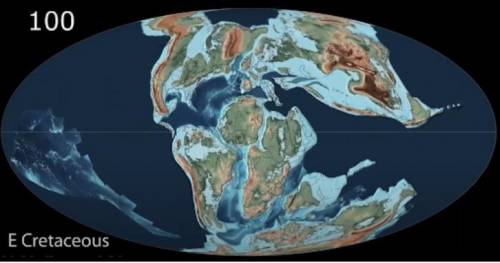
This is a map showing the approximate positions of the continents millions of years ago, after the breakup of the last supercontinent. Assume that South America and Africa diverged (separated) at an average rate of 3.5 cm/year (centimeters per year). If the two land masses are now 2850 km (kilometers) apart, how many years ago did they separate?
A. 1.2 • 10^8 years
B. 1.0 • 10^5 years
C. 1.2 • 10^7 years
D. 8.1 • 10^7 years
E. 8.14 • 10^5 years
F. 1.05 • 10^4 years


Answers: 1


Other questions on the subject: Physics

Physics, 21.06.2019 19:20, Obeilskzexal
Aferris wheel is a vertical, circular amusement ride with radius 9 m. riders sit on seats that swivel to remain horizontal. the ferris wheel rotates at a constant rate, going around once in 9 s. consider a rider whose mass is 56 kg. at the bottom of the ride, what is the perpendicular component of the rate of change of the rider's momentum? at the bottom of the ride, what is the vector force exerted by the seat on the rider?
Answers: 1

Physics, 21.06.2019 19:40, gonzalezjacquel7975
An uplifted block of rock between two normal faults
Answers: 1

Physics, 21.06.2019 21:40, taylordalton93
This problem has been solved! see the answera non-uniform fire escape ladder is 6.0m long whenextended to the icy alley below. it is held at the top by africtionless pivot, and there is neglibible frictional force fromthe icy surface at the bottom. the ladder weighs 250n, and it'scenter of gravity is 2.0m along the ladder from the bottom. amother and child of total weight 750n are on the ladder 1.5m fromthe pivot. the ladder makes an angle θ with the horizontal. find the magnitude and direction ofa) the force exerted by the icy alley on the ladderb) the force exerted by the ladder on the pivotc) do your answers in part a and b depend on the angle?
Answers: 3

Physics, 22.06.2019 04:00, johnandashley5p65r4a
Assume similar data for the motion of the blood in your aorta. estimate how many beats of the heart it will take the blood to get from your heart to your brain. (assume that the distance from your heart to your brain is 30 cm)
Answers: 2
You know the right answer?
This is a map showing the approximate positions of the continents millions of years ago, after the b...
Questions in other subjects:

Mathematics, 19.01.2021 01:00

Mathematics, 19.01.2021 01:00


History, 19.01.2021 01:00



Mathematics, 19.01.2021 01:00

Mathematics, 19.01.2021 01:00

Biology, 19.01.2021 01:00



